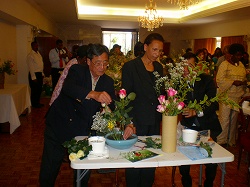|

|
|

|
| Ambassador's Speech>2012 >121105 | ||||
|
 |
|||
| at the Ikebana Demonstration at the Residence on 5 November, 2012 | ||||
| Excellencies, Distinguished Guests, Ladies and Gentlemen, Endemen ameshachehu. |
||||
| It is a great pleasure for me to welcome you all to my Residence, on this lovely occasion of an Ikebana Demonstration. This is the fourth event of the Japanese Cultural Series in Ethiopia for the JFY2012, swiftly following the Japanese Film Festival we had last month. For those who came to the opening night of the Festival and enjoyed the film ‘After the Flowers,’ it has already been shown that flowers and Nature are an important part of Japanese culture. This evening, we have three distinguished Ikebana experts with us. They are Master Instructor Mrs. Misei Ishikawa, Iemoto Assistant Mrs. Seika Kasuya and Iemoto Atelier Staff Mr. Koji Kurata. It is a great honour for me to have such prominent Ikebana experts here in Addis Ababa on their African tour. I would like to express my heartfelt appreciation to them for coming all the way from Japan to share with us the beauty and joy of Ikebana. I am also grateful to the Japan Foundation in Tokyo for sponsoring this event. My appreciation also goes to the Sululta Rose Farm, J.J. Kothari & Co, for contributing more than 350 beautiful roses for this program. Excellencies, Ladies and Gentlemen, The three Ikebana experts are all from the Sougetsu School, which was founded by Sofu Teshigahara in 1972. Ikebana or ‘Kado,’ which means ‘the way of flowers,’ has more than 500 years of history in Japan. There are many schools of Ikebana today, but the Sougetsu School recognizes Ikebana as a creative art, not necessarily sticking to established procedures or formats. The charm of the Sogetsu Ikebana style is that you can enjoy it anytime, anywhere, using any materials. This is especially suitable for us living abroad, where we cannot always find certain materials or tools usually used in Ikebana. With just a vase and some flowers, you are able to feel Japanese culture in your home. Ikebana is often translated as flower arrangement or arranging flowers. In a deeper sense of the word, however, it literally means ‘living or lively flowers.’ Like every living thing, each Ikebana is unique as each arrangement is created based upon different ideas and imagination, and in different ways. The flowers that the Ikebana experts are going to arrange tonight will ‘come alive’ or ‘become lively’ in front of our eyes, with inspiration and creativity. It will be Ikebana which is especially inspired by flowers in Addis Ababa and the people of Ethiopia. So, without further ado, let us have the Ikebana experts take us on a journey of the way of flowers! Amesegenalehu! |
||||
|
||||